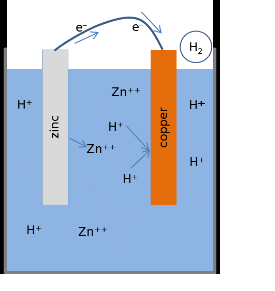Orange/Lemon Battery
- Page ID
- 131417
|
Required Training |
Required PPE |
|---|---|
|
UC Lab Safety Fundamentals |
Lab coat, safety glasses/goggles, nitrile gloves |
|
|
|
|
Equipment |
Chemicals |
|
Lemons or Oranges |
|
|
House setup of Zinc/Copper electrodes |
|
|
LED light, watch, or voltmeter to measure/visualize current |
|
Procedure:
- Insert the Cu and Zn electrodes into the fruit.
- Connect the metal clips to an LED light and see it glow (light is dim, so you may need to turn off the lights).
- Clips may also be attached to a watch to see the seconds hand move or to a voltmeter to measure the voltage
- Increasing the number of fruit will create a high voltage
- Be sure to wipe down the electrodes with a paper towel after use
Discussion:
The current derives from the oxidation of Zn metal and the reduction on H+ ions. Zn atoms dissolves in the acidic citrus juice leaving 2 negatively charged electrons (e-) behind in the Zn anode.
Zn → Zn2+ + 2 e-
As Zn enters the solution, 2 positively charged H+ ions pick up 2 electrons at the Cu cathode and form H2 gas.
2H+ + 2e- → H2
The electrons lost by Cu are replaced by 2 e- from the Zn anode that have traveled through the wire. The electrical current is produced by the movement of electrons in the circuit. During oxidation, Zn looses electrons to reach a lower energy state; the energy released provides the power to turn on the LED, start the watch, etc.

Hazards:
N/A
SOP
N/A
Disposal (by Storeroom)
Used lemons can be tossed in the trash.

